Sara Sarto
Recurrence Meets Transformers for Universal Multimodal Retrieval
Sep 10, 2025Abstract:With the rapid advancement of multimodal retrieval and its application in LLMs and multimodal LLMs, increasingly complex retrieval tasks have emerged. Existing methods predominantly rely on task-specific fine-tuning of vision-language models and are limited to single-modality queries or documents. In this paper, we propose ReT-2, a unified retrieval model that supports multimodal queries, composed of both images and text, and searches across multimodal document collections where text and images coexist. ReT-2 leverages multi-layer representations and a recurrent Transformer architecture with LSTM-inspired gating mechanisms to dynamically integrate information across layers and modalities, capturing fine-grained visual and textual details. We evaluate ReT-2 on the challenging M2KR and M-BEIR benchmarks across different retrieval configurations. Results demonstrate that ReT-2 consistently achieves state-of-the-art performance across diverse settings, while offering faster inference and reduced memory usage compared to prior approaches. When integrated into retrieval-augmented generation pipelines, ReT-2 also improves downstream performance on Encyclopedic-VQA and InfoSeek datasets. Our source code and trained models are publicly available at: https://github.com/aimagelab/ReT-2
LLaVA-MORE: A Comparative Study of LLMs and Visual Backbones for Enhanced Visual Instruction Tuning
Mar 19, 2025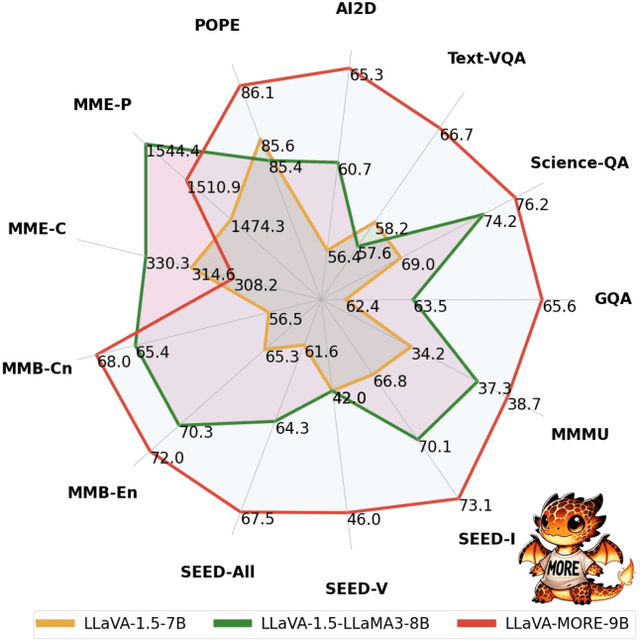
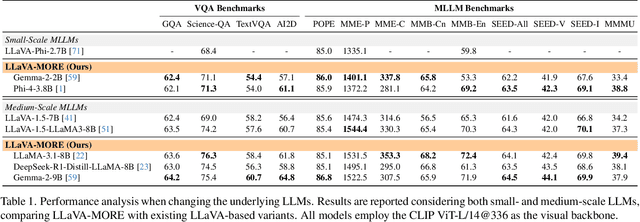
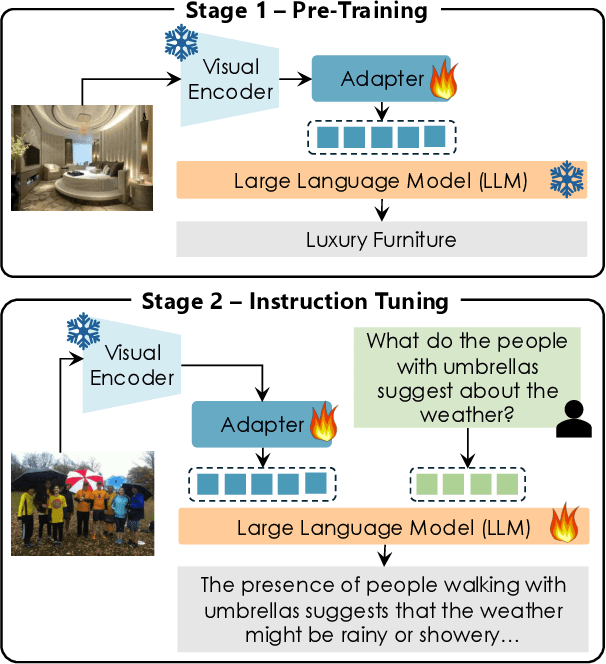

Abstract:Recent progress in Multimodal Large Language Models (MLLMs) has highlighted the critical roles of both the visual backbone and the underlying language model. While prior work has primarily focused on scaling these components to billions of parameters, the trade-offs between model size, architecture, and performance remain underexplored. Additionally, inconsistencies in training data and evaluation protocols have hindered direct comparisons, making it difficult to derive optimal design choices. In this paper, we introduce LLaVA-MORE, a new family of MLLMs that integrates recent language models with diverse visual backbones. To ensure fair comparisons, we employ a unified training protocol applied consistently across all architectures. Our analysis systematically explores both small- and medium-scale LLMs -- including Phi-4, LLaMA-3.1, and Gemma-2 -- to evaluate multimodal reasoning, generation, and instruction following, while examining the relationship between model size and performance. Beyond evaluating the LLM impact on final results, we conduct a comprehensive study of various visual encoders, ranging from CLIP-based architectures to alternatives such as DINOv2, SigLIP, and SigLIP2. Additional experiments investigate the effects of increased image resolution and variations in pre-training datasets. Overall, our results provide insights into the design of more effective MLLMs, offering a reproducible evaluation framework that facilitates direct comparisons and can guide future model development. Our source code and trained models are publicly available at: https://github.com/aimagelab/LLaVA-MORE.
Image Captioning Evaluation in the Age of Multimodal LLMs: Challenges and Future Perspectives
Mar 18, 2025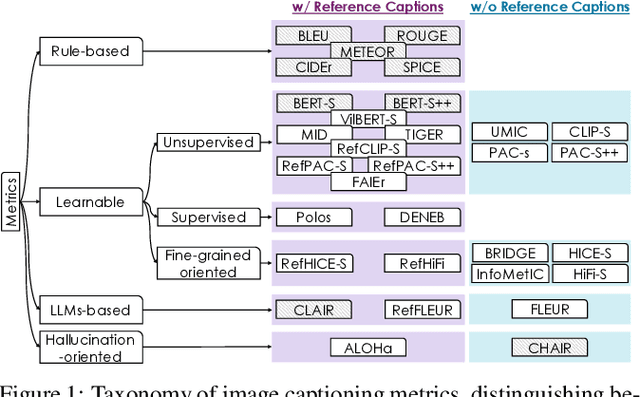
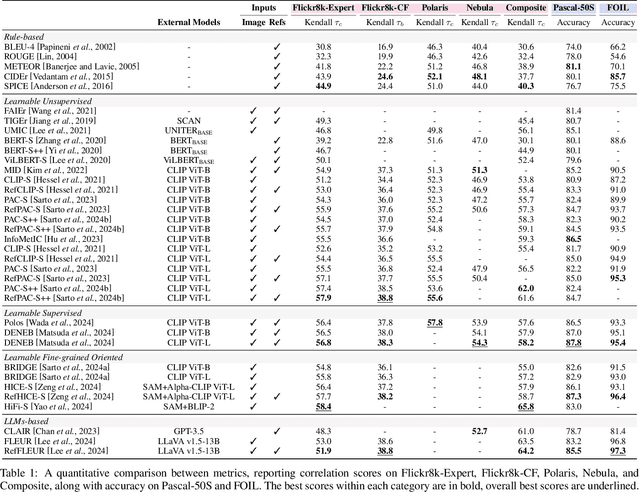
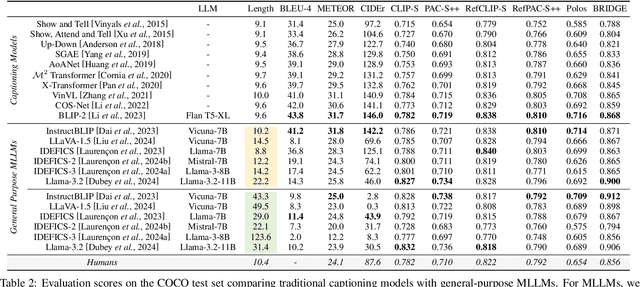

Abstract:The evaluation of machine-generated image captions is a complex and evolving challenge. With the advent of Multimodal Large Language Models (MLLMs), image captioning has become a core task, increasing the need for robust and reliable evaluation metrics. This survey provides a comprehensive overview of advancements in image captioning evaluation, analyzing the evolution, strengths, and limitations of existing metrics. We assess these metrics across multiple dimensions, including correlation with human judgment, ranking accuracy, and sensitivity to hallucinations. Additionally, we explore the challenges posed by the longer and more detailed captions generated by MLLMs and examine the adaptability of current metrics to these stylistic variations. Our analysis highlights some limitations of standard evaluation approaches and suggests promising directions for future research in image captioning assessment.
Recurrence-Enhanced Vision-and-Language Transformers for Robust Multimodal Document Retrieval
Mar 03, 2025Abstract:Cross-modal retrieval is gaining increasing efficacy and interest from the research community, thanks to large-scale training, novel architectural and learning designs, and its application in LLMs and multimodal LLMs. In this paper, we move a step forward and design an approach that allows for multimodal queries, composed of both an image and a text, and can search within collections of multimodal documents, where images and text are interleaved. Our model, ReT, employs multi-level representations extracted from different layers of both visual and textual backbones, both at the query and document side. To allow for multi-level and cross-modal understanding and feature extraction, ReT employs a novel Transformer-based recurrent cell that integrates both textual and visual features at different layers, and leverages sigmoidal gates inspired by the classical design of LSTMs. Extensive experiments on M2KR and M-BEIR benchmarks show that ReT achieves state-of-the-art performance across diverse settings. Our source code and trained models are publicly available at https://github.com/aimagelab/ReT.
Positive-Augmented Contrastive Learning for Vision-and-Language Evaluation and Training
Oct 09, 2024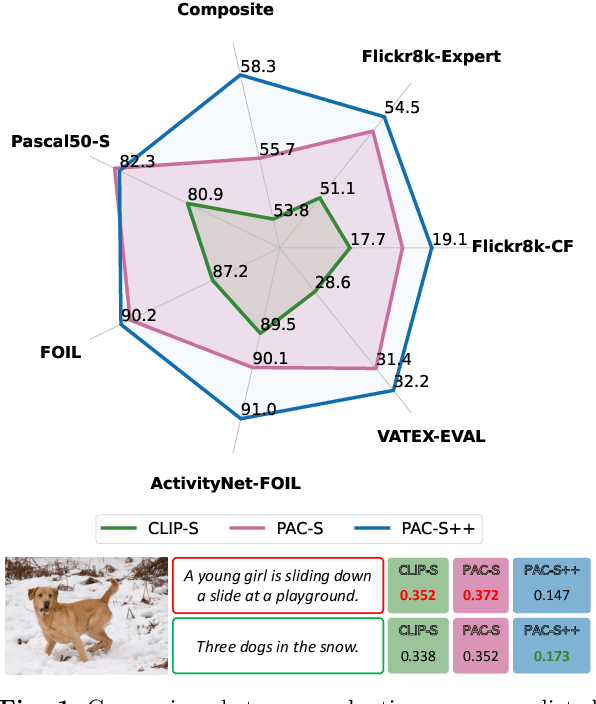
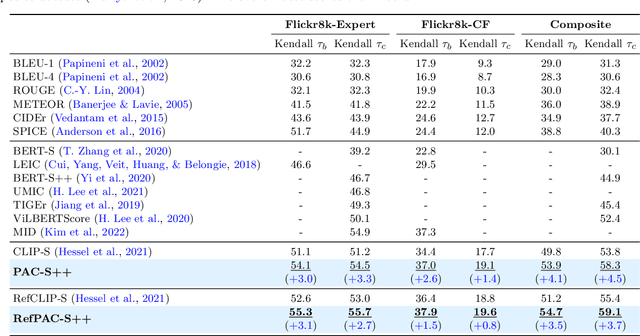
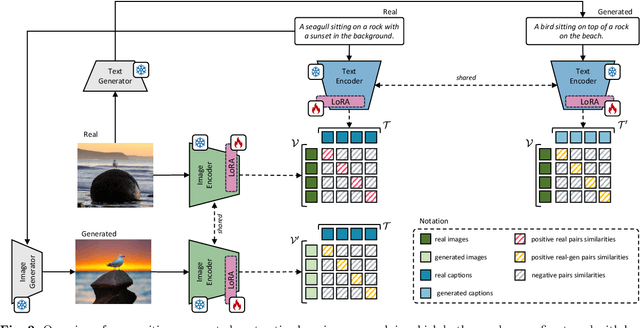
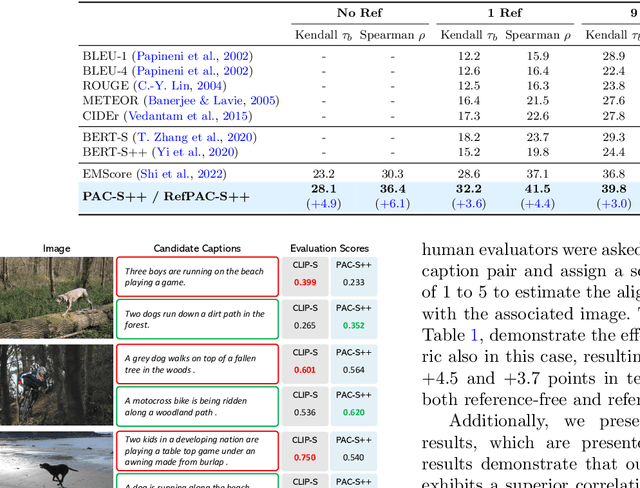
Abstract:Despite significant advancements in caption generation, existing evaluation metrics often fail to capture the full quality or fine-grained details of captions. This is mainly due to their reliance on non-specific human-written references or noisy pre-training data. Still, finding an effective metric is crucial not only for captions evaluation but also for the generation phase. Metrics can indeed play a key role in the fine-tuning stage of captioning models, ultimately enhancing the quality of the generated captions. In this paper, we propose PAC-S++, a learnable metric that leverages the CLIP model, pre-trained on both web-collected and cleaned data and regularized through additional pairs of generated visual and textual positive samples. Exploiting this stronger and curated pre-training, we also apply PAC-S++ as a reward in the Self-Critical Sequence Training (SCST) stage typically employed to fine-tune captioning models. Extensive experiments on different image and video datasets highlight the effectiveness of PAC-S++ compared to popular metrics for the task, including its sensitivity to object hallucinations. Furthermore, we show that integrating PAC-S++ into the fine-tuning stage of a captioning model results in semantically richer captions with fewer repetitions and grammatical errors. Evaluations on out-of-domain benchmarks further demonstrate the efficacy of our fine-tuning approach in enhancing model capabilities. Source code and trained models are publicly available at: https://github.com/aimagelab/pacscore.
BRIDGE: Bridging Gaps in Image Captioning Evaluation with Stronger Visual Cues
Jul 29, 2024



Abstract:Effectively aligning with human judgment when evaluating machine-generated image captions represents a complex yet intriguing challenge. Existing evaluation metrics like CIDEr or CLIP-Score fall short in this regard as they do not take into account the corresponding image or lack the capability of encoding fine-grained details and penalizing hallucinations. To overcome these issues, in this paper, we propose BRIDGE, a new learnable and reference-free image captioning metric that employs a novel module to map visual features into dense vectors and integrates them into multi-modal pseudo-captions which are built during the evaluation process. This approach results in a multimodal metric that properly incorporates information from the input image without relying on reference captions, bridging the gap between human judgment and machine-generated image captions. Experiments spanning several datasets demonstrate that our proposal achieves state-of-the-art results compared to existing reference-free evaluation scores. Our source code and trained models are publicly available at: https://github.com/aimagelab/bridge-score.
Towards Retrieval-Augmented Architectures for Image Captioning
May 21, 2024



Abstract:The objective of image captioning models is to bridge the gap between the visual and linguistic modalities by generating natural language descriptions that accurately reflect the content of input images. In recent years, researchers have leveraged deep learning-based models and made advances in the extraction of visual features and the design of multimodal connections to tackle this task. This work presents a novel approach towards developing image captioning models that utilize an external kNN memory to improve the generation process. Specifically, we propose two model variants that incorporate a knowledge retriever component that is based on visual similarities, a differentiable encoder to represent input images, and a kNN-augmented language model to predict tokens based on contextual cues and text retrieved from the external memory. We experimentally validate our approach on COCO and nocaps datasets and demonstrate that incorporating an explicit external memory can significantly enhance the quality of captions, especially with a larger retrieval corpus. This work provides valuable insights into retrieval-augmented captioning models and opens up new avenues for improving image captioning at a larger scale.
Wiki-LLaVA: Hierarchical Retrieval-Augmented Generation for Multimodal LLMs
Apr 23, 2024



Abstract:Multimodal LLMs are the natural evolution of LLMs, and enlarge their capabilities so as to work beyond the pure textual modality. As research is being carried out to design novel architectures and vision-and-language adapters, in this paper we concentrate on endowing such models with the capability of answering questions that require external knowledge. Our approach, termed Wiki-LLaVA, aims at integrating an external knowledge source of multimodal documents, which is accessed through a hierarchical retrieval pipeline. Relevant passages, using this approach, are retrieved from the external knowledge source and employed as additional context for the LLM, augmenting the effectiveness and precision of generated dialogues. We conduct extensive experiments on datasets tailored for visual question answering with external data and demonstrate the appropriateness of our approach.
The (R)Evolution of Multimodal Large Language Models: A Survey
Feb 19, 2024Abstract:Connecting text and visual modalities plays an essential role in generative intelligence. For this reason, inspired by the success of large language models, significant research efforts are being devoted to the development of Multimodal Large Language Models (MLLMs). These models can seamlessly integrate visual and textual modalities, both as input and output, while providing a dialogue-based interface and instruction-following capabilities. In this paper, we provide a comprehensive review of recent visual-based MLLMs, analyzing their architectural choices, multimodal alignment strategies, and training techniques. We also conduct a detailed analysis of these models across a wide range of tasks, including visual grounding, image generation and editing, visual understanding, and domain-specific applications. Additionally, we compile and describe training datasets and evaluation benchmarks, conducting comparisons among existing models in terms of performance and computational requirements. Overall, this survey offers a comprehensive overview of the current state of the art, laying the groundwork for future MLLMs.
With a Little Help from your own Past: Prototypical Memory Networks for Image Captioning
Aug 23, 2023Abstract:Image captioning, like many tasks involving vision and language, currently relies on Transformer-based architectures for extracting the semantics in an image and translating it into linguistically coherent descriptions. Although successful, the attention operator only considers a weighted summation of projections of the current input sample, therefore ignoring the relevant semantic information which can come from the joint observation of other samples. In this paper, we devise a network which can perform attention over activations obtained while processing other training samples, through a prototypical memory model. Our memory models the distribution of past keys and values through the definition of prototype vectors which are both discriminative and compact. Experimentally, we assess the performance of the proposed model on the COCO dataset, in comparison with carefully designed baselines and state-of-the-art approaches, and by investigating the role of each of the proposed components. We demonstrate that our proposal can increase the performance of an encoder-decoder Transformer by 3.7 CIDEr points both when training in cross-entropy only and when fine-tuning with self-critical sequence training. Source code and trained models are available at: https://github.com/aimagelab/PMA-Net.
 Add to Chrome
Add to Chrome Add to Firefox
Add to Firefox Add to Edge
Add to Edge